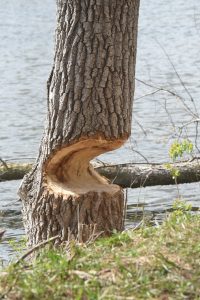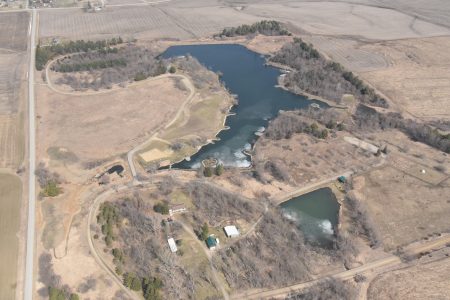Big rodents make Green Castle home

Photos by Garry Brandenburg — Mother Nature has industrial engineers at work and on call. Where she assigns them to work on chewing trees and other woody vegetation is part of the mystery of natural history. These ‘engineers’ are a our largest rodent, the American Beaver, (Castor canadensis). And Green Castle last year became new home territory for some of these critters. Home to the beaver means any tree in the vicinity is fair game to chew on, to fell it, and then to cut off smaller branches to feed on. The beaver have created underwater entrances to bank dens with spaces above water line to stay dry. Beaver can be a nuisance is quick order. In the case at Green Castle, Marshall County Conservation staff had to close the park temporarily to people to allow cleanup of fallen trees from the beaver. Friend or foe, it all depends on location and how their actions have either positive or negative impacts on people. There is no question that beavers can significantly modify their environments.
THE BEAVER (Castdor canadensis) is one animal of our natural world that many people never see. Active at night, they may work overtime to build small or medium log, stick and mud dams across area creeks or small streams. Behind those impoundments of shallow water, an area creek can be transformed into a series of small stepping stone “mini-lakes.” And if the beaver family decides to go exploring, they do so largely unseen and unheard. What people discover a few days, weeks or months later are lots of trees cut down, or chewed through to make the tree a hazard to the next wind storm, or in some cases, adjacent field crop damages may become evident.
Beavers have a stocky body with yellow-brown dense fur. A flat and wide scaly tail is used for propulsion and signaling to others if danger is perceived. Webbed feet on the hind legs also help with swimming. As a rodent, they have large incisor teeth that grow continually. Wear is accomplished daily by the action of what they eat. And as bottom and top incisors meet, a bit of natural carving and shaping takes place to make the teeth work like perfect chisels.
The hind feet of beavers have a unique hind toe, the second from the inside with a double toenail. They use those feet to groom their fur meticulously to keep oils on the fur and prevent matting of their fur. While walking on land is not their biggest or finest of actions, in the water it is a completely different story — excellent and agile swimmers they can propel themselves at 6 mph. They also have large lungs that allow them to stay submerged for 15 minutes.
A face full of whiskers helps the animal detect underwater passageways, or find food. Its eye has a nictating membrane that closes over the eye for underwater work. It has external ears but valves close during underwater activities. Beaver tails are used for movement in water, for balance when out of water, or as a signal of danger when they slap the tail hard against the water’s surface. Fat is stored in the tail for winter time if food is scarce. Anatomically the vertebrae of a beaver continues into the tail almost to the tail tip. The weight of an adult beaver can be 35 to 65 pounds. The heaviest beaver recorded was 110 pounds. A long time ago geologically, giant beavers once were part of the landscape. These extinct beavers were huge. Fossil records are impressive for the giant beaver. The body of our common beaver is 3 to 4 feet long and height is about 1 to 1.5 feet.
Dome-like lodges mafy be common in marsh or lake habitats. A big dome lodge may rise more than 6 feet above the water line with two or more underwater entrances. The dome acts like a little island habitat surrounded by water. Living quarters are in the top center of the lodge where they can be dry. Small ventilation air holes bring fresh air into the den. Wood shavings act as bedding for these critters. Wood shavings can come from any of their preferred foods…willow, poplar, cottonwood, aspen, birch and maple.

Family bonds are strong for beavers. As social animals, each group is made up of one breeding pair, the young kits and surviving offspring from the previous year. It is believed that the dominant beaver pair are mates for life. Mating takes place from January to February. Kits are born in the spring and weigh about 1 pound, are covered in fur and their eyes are open. The young will remain in the family unit for two years and learn how to find food, conduct lodge maintenance and assist with raising younger siblings.
Experienced trappers who attempt to remove beaver from areas where they are creating problems will have their work cut out for them. Taking just one or two beavers will not solve the problem. Removing the entire family is the goal, but a goal that is very hard to achieve. Beaver trapping requires skills to set the right rigging, and be dedicated to long hours of work before, during and after.
Area fishermen and women have plied the shoreline of Green Castle since mid-March. Evidence of beaver action was not hard to find. Many trees were damaged. Staff of the MCCB have taken those trees out. However, more trees became victims of beaver energy this spring. Trees felled or weakened substantially are easily observed. It is true the beavers at Green Castle are modifying the site to suit themselves without regard to our human aspirations. Learning to live with beaver will be an on-going fact of life. Those big rodent engineers are likely to win their game.
Out and about this past week, once hard-to-find PHEASANTS seem to be more common. Rooster pheasants crowing have made their cackling call quite apparent. Even if I cannot see them, I heard them. And that is good. Then in some of the most strangest of locations, a rooster and hen pheasant erupted from a roadside grassy ditch bank and flew across the roadway safely out of the way of my vehicle’s windshield and grill. A relatively dry spring will be good news for hen pheasant nesting. Gentle rains will be welcome to all wildlife, and area farmers. Gully washer rains not so much. We can only ask Mother Nature to be gentle with her rainwater from the sky during May.
MAY is our new month. The day length for us living at 42 degrees north latitude is 14 hours and 5 minutes Sunday. By May 31, the day will be 15 hours long. Those long days of long sunlight hours will be magic for all green growing things. Photosynthesis, the process of sunlight action on leaf chlorophyll, will make sugars for all plants.
Also during May, get ready to go fishing for walleye in Iowa’s Great Lakes. This fishing season opened Saturday. Bluebirds will hatch their first of two broods on or about mid May. Mid-May should also see the return of Bobolinks who spent their winter in Argentina. Pheasant hatches can begin on or about May 19 if good weather allows. On May 26, a total lunar eclipse will happen, cloud cover absent to permit us humans to watch it. And lastly, from the long ago weather record books, on May 28, 1947, the northwest two-thirds of Iowa got 10 inches of snow. Put that in your trivia memory bank.
Here is my parting thought to ponder on. Considering the eternity of time that has preceded us, and all the eternity of time that will follow our passing, take note of these words from native American Blackfoot Indians. “What is life? It is the flash of a firefly in the night. It is the breath of a buffalo in wintertime. It is the little shadow which runs across the grass and loses itself in the sunset.”
Garry Brandenburg is the retired director of the Marshall County Conservation Board. He is a graduate of Iowa State University with a BS degree in Fish & Wildlife Biology.
Contact him at:
P.O. Box 96
Albion, IA 50005
- Photos by Garry Brandenburg — Mother Nature has industrial engineers at work and on call. Where she assigns them to work on chewing trees and other woody vegetation is part of the mystery of natural history. These ‘engineers’ are a our largest rodent, the American Beaver, (Castor canadensis). And Green Castle last year became new home territory for some of these critters. Home to the beaver means any tree in the vicinity is fair game to chew on, to fell it, and then to cut off smaller branches to feed on. The beaver have created underwater entrances to bank dens with spaces above water line to stay dry. Beaver can be a nuisance is quick order. In the case at Green Castle, Marshall County Conservation staff had to close the park temporarily to people to allow cleanup of fallen trees from the beaver. Friend or foe, it all depends on location and how their actions have either positive or negative impacts on people. There is no question that beavers can significantly modify their environments.








